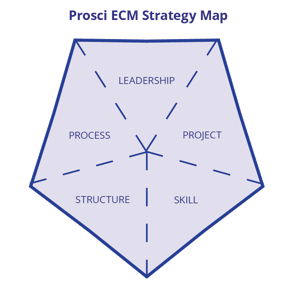5 Tips for Building Organizational Change Management

5 Mins
Updated: September 2, 2022
Published: August 18, 2015

During the summer of 2009, Prosci will be releasing a number of "Five tips" tutorials. These tutorials will provide simple, actionable steps to improving change management application. Each tutorial will focus on a particular element of change management, including:
- Five tips for: Succeeding in change management
- Five tips for: Sizing your change management efforts
- Five tips for: Better communications
- Five tips for: Managing resistance
This "Five tips" tutorial looks at building organizational change management competency . The tips come directly from practitioner experience and benchmarking data from Prosci's six benchmarking studies conducted over the last 12 years.
Five tips for: Building organizational change management competency
- Treat it as a project
- Treat it as a change
- Utilize a holistic strategy
- Dedicate a team
- Secure sponsorship
* Note: Defining "organizational change management competency" - Change management is defined as the principles, tools and processes for managing the people side of a particular organizational change in order to meet objectives. It involves appreciating and facilitating the individual behavioral and work flow changes that a particular initiative requires - whether it is a process change, a new technology or a reorganization. Conversely, organizational change management competency moves beyond application on a particular, defined change. It includes the application of common tools and processes on numerous initiatives as well as the building of individual competencies in senior leaders, managers, supervisors, employees and project teams. The result is a strategic capability of being effective at introducing change. Prosci calls this "Enterprise Change Management" - rolling out the skills and processes to effectively manage the people side of change across an entire organization.
1. Treat it as a project
Deploying change management across an organization is not a simple undertaking. It does not occur as a single announcement or decree by senior leaders. And it does not occur by simply training people about how to manage change. When you build organizational competencies in change management, you are fundamentally changing how the organization handles change.
To successfully build an organizational competency - not just change management competency but any organizational competency - it is critical to view this work as a project. The project needs structure. It needs someone to manage the project. And it needs a team to evaluate, design and deploy the approach. "Change management deployment" should be viewed as and managed as a project.
As you think about change management deployment as a project, there are steps for vision, strategy and implementation that guide the project. In the vision stage, the team taking on change management competency building defines the future state - what will it look like when the organization becomes competent at managing change - and assess the current state - evaluating the levers and risks facing the deployment effort. Through the strategy and implementation phases, options are evaluated and decisions are made on how to structure and sequence the deployment effort. This work culminates in a project plan, just like any other project that impacts the organization.
When change management deployment is not treated as a project, there can be a lot of activity with little progress. Direction is needed to guide the deployment efforts and ensure alignment toward a future state of being change competent (or durable or flexible).
Are you treating change management deployment as a project?
2. Treat it as a change
Not only should change management competency building be viewed as a project, it must also be viewed as a change to how people work. When you ask senior leaders to begin taking on the role of sponsor, they must change how they do their jobs. When you ask project teams to begin applying change management processes and integrating "people side" activities into their project plans, they must change how they do their jobs. When you ask front-line managers and supervisors to become effective coaches of their direct reports in times of change, they must change how they do their jobs. Applying change management impacts the day-to-day work of many people in the organization, and you need to take this change into consideration.
To say it another way, it takes change management to deploy change management. Consider "applying change management" as a change you are trying to bring about. This effort will require both organizational change management - a structured approach and set of tools (like a communications plan, sponsor roadmap, coaching plan, training plan and resistance management plan) - and individual change management.
Prosci's ADKAR Model describes five key building blocks of any successful change - Awareness, Desire, Knowledge, Ability and Reinforcement. In the change management competency building context, this would translate as:
- Awareness of the need for change management
- Desire to participate and support change management
- Knowledge on how to apply change management
- Ability to implement required change management skills and behaviors
- Reinforcement to sustain change management application
Be careful - many change management practitioners have made the mistake of ignoring change management when they work to deploy it. When you take on the challenge of building change management competency in the organization, you must utilize change management to improve the speed of adoption, utilization and proficiency of applying change management.
Are you managing the people side of change management deployment?
3. Utilize a holistic strategy
Building an organizational competency to manage change does not occur by simply training some people. It does not happen simply by weaving change management activities into a project lifecycle. To be successful, a holistic and structured approach much be used. Prosci's research indicates five strategic areas that must be leveraged to build the organizational change management competency. The image below shows Prosci's ECM Strategy Map:

Specific tactics need to be developed in each of the five areas shown in the strategy map. There must be effective leadership in place driving the change management deployment efforts. Decisions must be made on how to attach change management to projects in the organization. People will need to build new skills - "managing change" is a new and emerging competency and you must help people in the organization build that competency. Change management needs an "organizational footprint" - a structure to support change management application by people throughout the organization. Finally, business processes that already exist in the organization should be adapted to incorporate change management - including performance management processes and project launch processes.
While the five areas seem simple, there should be a well thought-out, sequenced set of tactics under each of the five areas. A holistic approach ensures that energy is not expended simply on getting change management started, but that its application in the organization is long-lasting and sustained.
Is your approach to deploying change management holistic and structured?
4. Dedicate a team
Someone has to do the work described above. A team needs to be in place to manage the project of "deploying change management" - to build out the change management plans necessary to manage the people side of this change and to develop the specific tactics that will ultimately bring change management to life in the organization.
Effective teams are representative of the organization and how changes occur in the organization. It is not adequate to simply have a small team of specialists in one functional area. Prosci's research shows that change management should have a presence in Human Resources, the Project Management Office and in business functions or units that cause change (such as IT or a Process Improvement group). The lines of business should also be involved, as managers and supervisors throughout the organization will also be impacted. The team that is deciding how to roll out change management should also have representation from these different groups so the set of tactics developed are applicable.
Do you have a representative team leading change management deployment?
5. Secure sponsorship
Although sponsorship is the last in our five tips, it is certainly number one in terms of impact on success. Building the organizational competency - becoming flexible and durable as an organization - requires considerable work and causes considerable change. It impacts how projects are conceived and launched. It impacts how project teams move forward in their work. It impacts how senior leaders, middle managers, front-line supervisors and employees see themselves in relation to change and how they behave. With this size of enterprise-wide effort impacting nearly the entire employee base, sponsorship must be effective, active, engaged and well-positioned.
According to Prosci's benchmarking research, there are three primary roles of sponsors in times of change - 1) participate actively and visibly throughout the entire project, 2) build a coalition with key leaders and managers and 3) communicate directly with employees. Research indicates that the more effective sponsors are at fulfilling these three roles, the more successful the change effort will be. Why would the project called "deploying change management" be any different?
Building change management competency requires the same active and visible engagement by senior leaders as any other organizational effort.
Do you have the sponsorship necessary to deploy an organization-wide change?


